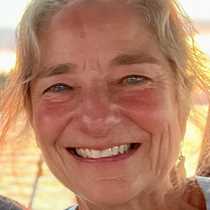San Pedro Martir
Our shipboard voyage started late yesterday afternoon, when we left Puerto Escondido’s snug, picturesque harbor. As we entered the Gulf of California, dramatic mountains of the Baja peninsula’s Sierra de la Gigante were on one side, and Isla Carmen on the other. With such stunning scenery all around it's difficult to decide which way to look! Then more competition for our attention: bottlenose dolphins and a humpback whale! All of this within 3 hours of embarking. We finally headed north and traveled through the night.
At first light we could see San Pedro Martir to the north. This is an especially rich region in the Gulf. Upwelling forces nutrient-rich water from a submarine canyon towards the surface, nourishing the marine food web. At sunrise the sea surface was like glass . . . ideal for finding marine life. That we did – and what an amazing first day we have had!
Breakfast had barely begun when it was interrupted: “There are bottlenose dolphins near the ship!” As the meal came to an end, a larger cetacean was seen: a Bryde’s whale. We patiently watched for its falcate dorsal fin to break the surface but this individual was, typically for this species, hard to track. As we prepared for the required abandon ship drill, yet another species was seen, and the drill was postponed. Sperm whales! There were numerous groups of 4-5 whales, in all directions around the ship. We had excellent views of their square, bulbous heads, slanted blows, wrinkly-wrinkly skin and black tail flukes. At times we could see their bodies underwater.
Naturalist Carlos Navarro snorkeled briefly near the whales with the underwater video camera. Imagine what he felt: afloat in water 3000 feet deep, 35-foot long whales swimming towards him and continuously sending powerful echolocation pulses through his body. The whales swam close by the lone human snorkeler.
As the Zodiac returned Carlos to the ship, groups of bottlenose dolphins leapt and jumped alongside it. What a spectacular sight! Dolphins rode the ship’s bow wave, too. With glassy water, we could see their bodies perfectly. We were surrounded - and it sure was fun.
We had an abandon ship drill, then lunch, then ice cream sundaes. Our stomachs and our photo cards were full.
For the afternoon we investigated San Pedro Martir by Zodiac. The island is absolutely stunning: thousands of seabirds, California sea lions, salty caves, narrow ledges, white cliffs, all topped by high slopes covered by white icing (guano) and cardon cacti. There’s no other place like it. Blue-footed boobies, brown boobies, and red-billed tropicbirds dominated the skies. The water below was teeming with newly hatched fish fry. This region is overwhelmed with life, and I am overwhelmed. What a beautiful place to experience.
Our shipboard voyage started late yesterday afternoon, when we left Puerto Escondido’s snug, picturesque harbor. As we entered the Gulf of California, dramatic mountains of the Baja peninsula’s Sierra de la Gigante were on one side, and Isla Carmen on the other. With such stunning scenery all around it's difficult to decide which way to look! Then more competition for our attention: bottlenose dolphins and a humpback whale! All of this within 3 hours of embarking. We finally headed north and traveled through the night.
At first light we could see San Pedro Martir to the north. This is an especially rich region in the Gulf. Upwelling forces nutrient-rich water from a submarine canyon towards the surface, nourishing the marine food web. At sunrise the sea surface was like glass . . . ideal for finding marine life. That we did – and what an amazing first day we have had!
Breakfast had barely begun when it was interrupted: “There are bottlenose dolphins near the ship!” As the meal came to an end, a larger cetacean was seen: a Bryde’s whale. We patiently watched for its falcate dorsal fin to break the surface but this individual was, typically for this species, hard to track. As we prepared for the required abandon ship drill, yet another species was seen, and the drill was postponed. Sperm whales! There were numerous groups of 4-5 whales, in all directions around the ship. We had excellent views of their square, bulbous heads, slanted blows, wrinkly-wrinkly skin and black tail flukes. At times we could see their bodies underwater.
Naturalist Carlos Navarro snorkeled briefly near the whales with the underwater video camera. Imagine what he felt: afloat in water 3000 feet deep, 35-foot long whales swimming towards him and continuously sending powerful echolocation pulses through his body. The whales swam close by the lone human snorkeler.
As the Zodiac returned Carlos to the ship, groups of bottlenose dolphins leapt and jumped alongside it. What a spectacular sight! Dolphins rode the ship’s bow wave, too. With glassy water, we could see their bodies perfectly. We were surrounded - and it sure was fun.
We had an abandon ship drill, then lunch, then ice cream sundaes. Our stomachs and our photo cards were full.
For the afternoon we investigated San Pedro Martir by Zodiac. The island is absolutely stunning: thousands of seabirds, California sea lions, salty caves, narrow ledges, white cliffs, all topped by high slopes covered by white icing (guano) and cardon cacti. There’s no other place like it. Blue-footed boobies, brown boobies, and red-billed tropicbirds dominated the skies. The water below was teeming with newly hatched fish fry. This region is overwhelmed with life, and I am overwhelmed. What a beautiful place to experience.



